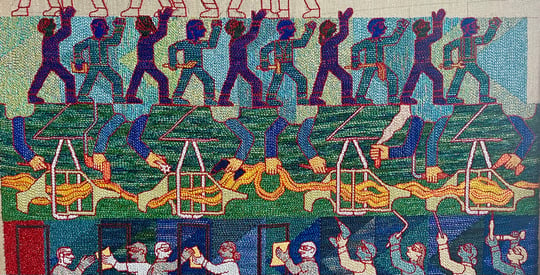
From a distance, Fragments of the City recalls the wall of a college dorm room, curated with Instax mini pictures: 2” x 3” exposures captured in passing, to be cherished after everyone has gone home. Beyond the “vintage” visual appeal of Polaroid pictures, in our post-quarantine world, there has been a palpable collective compulsion to savor and remember moments exactly as they are, to freeze time. Now that high-resolution cameras are more widely accessible, exacting the distinct granularity of experience holds less currency; the need to observe often and keenly the variable incidents of one’s life is all the more urgent. When turned toward the public, individual perceptions replicated visually become a kind of collective world-building. Such is the project of Sebastian Maseri’s exhibition Fragments of the City, a tapestry of memory affixed to the back wall of Dalé Zine in Little Haiti.
Composed of 210 evenly spaced 2.5” x 3.25” oil pastel drawings, the exhibition depicts passing moments of Maseri’s life in his native Miami, Mexico City (CMDX), and New York City, where he lives now. Each drawing has a geographic depth where the oil pastel accumulates with the rapidity of gesture, conceived more out of the urgency to define the landscape and his experience within it, than to luxuriate in process. “The drawings I make are quick and are influenced by day to day life and what I happen to experience,” Maseri confided.
To be sure, the drawings are deceivingly simple; rendered in bold, elementary colors, many of his subjects are legible to a discerning eye, the form of a fox, a canoe, a chessboard centered squarely within a neat paper frame. Other pieces, however, are less graphically immediate: the figure of an animal traipses through a red landscape, a ladder extends up a structure that could be a police observation tower or a dunk tank awaiting a school principal. At times, the illegibility grows ominous: a face peers through what could be the bars of a prison cell, or a window spliced by vertical blinds.
In a recent exhibition review for Hyperallergic, arts writer and human rights lawyer Jake Romm said, “There is a kind of decay that is accomplished not through subtraction, but rather through accumulation.” In aggregate, memories begin to lose context and definition, blur into one other or become entirely irretrievable. The lapses in legibility across Maseri’s drawings recall this same phenomenon, instances in his day to day life at times more defined than others.
The irrelevance of legibility across the exhibition makes me wonder what about memory is more valuable – the fact of its happening, its existence in a certain time and space, or our ability to recall it in perfect detail? In the end, an object or event is larger, less time-bound than us; our documentation of it, a mere symptom of perception, and our recollection of it, doomed to be overwritten. By refraining from trying to make sense of his memories, Maseri attempts to remove his ego from the equation, and as an anonymous human observer, present only what he knows to be true, or what he can prove through physical evidence.
Throughout this process, Maseri encounters a philosophical tug-of-war between the reality of a thing and his perception of it. By observing the thing, the fact of it is already slipping away from him. Working from rubbings and photographs, Maseri tackles the physical manifestation of his subjects head-on, and still Maseri’s character ekes its way into the process through instinctual choices regarding composition, color, and gesture. Maseri cites the Honduran short story writer Augusto Monterroso as an influence in his creative approach: “Monterroso’s writing…comes from a similar place of a one-to-one relationship between the idea and the work. Almost like a direct translation? There’s something that interests me about representing things that are more complicated in a simple format.” In reflecting on it, I can’t help but recall one of Maseri’s favorite works by Monterroso:
LA OVEJA NEGRA/ THE BLACK SHEEP
Many years ago, in a distant country, there was a Black Sheep.
He was shot.
A century later, the repentant flock erected an equestrian statue of him which looked very good in the park.
Thus, every time black sheep appeared they were rapidly executed so that the future generations of common, ordinary sheep could also practice their sculpture.
Fragments of the City works not because Maseri is successful in conveying his felt experience of a city, or the exact reality of it, but because that split difference, in tandem with the humility and lightheartedness of the works, leaves room for personal projection, the viewer’s own contribution. As the exhibition progressed, each drawing was sold off piece by piece. The relation between the works exploded, only to be witnessed again in Maseri’s limited run of zines documenting select works in the exhibition. As each fragment of Maseri’s experience was dispersed, intended or not, the sale of the works became a more formalized invitation for viewers to become active participants in the exhibition itself, so that the stories of each of these cities would take on new life through individual interpretation.
Fragments of the City is on view at Dale Zine Shop from August 5th until August 31st, 2023.

This piece was published in partnership with Oolite Arts as part of a project to increase critical arts coverage in Miami-Dade County.





